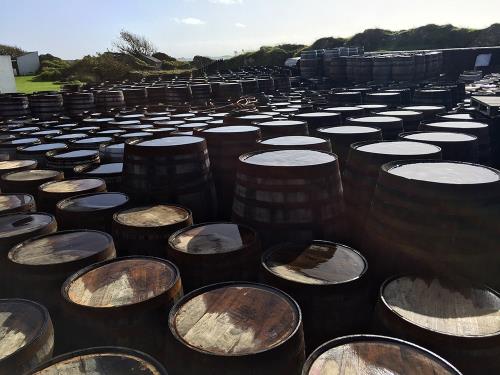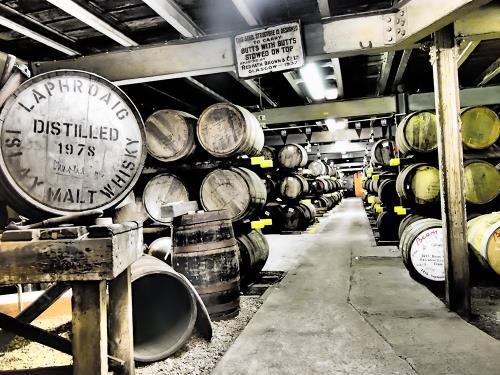Get to grips with the regions - A guide to Scotland's great whisky regions
In the early days of whisky production, casks were not used to age whisky in the same way as they are today. Back then, casks were primarily used for transportation, so you just used whatever you could get your hands on. These were typically casks of various sizes that had already been used for something else, such as beer, wine, and ciders.
It is believed that the positive effect that cask aging has on whisky was discovered by market traders and nobles who bought large quantities of spirits at a time and stored them in various wooden casks over the years. It was discovered that the spirit only got better with time, leading to the increased popularity of whisky.
A multitude of different types of barrels have been used to store whisky and other forms of alcohol over the years. The vast majority of them are still in use today, with a few others.
Barrels/barrel capacity is indicated by different names, which also serve as a unit of measurement. Many of these names/units of measurement date back to the 15th century, long before the existence of whisky as we know it today. The casks most commonly used in whisky production today are
Hogsheads, Puncheons, Butts/pipes, Quarter cask and American Standard/Bourbon. A smaller cask such as an
Octave cask, has the unique feature of being able to extract an incredible amount of cask character and flavor from a whisky in a short period of time. However, you can't cheat your way to a perfect whisky just by using small casks for maturation. This is because the spritzy and rancid nature of the alcohol itself only ages with time. The independent bottler Duncan Taylor publishes a range of single malts called ''the octave''' which are aged in these fascinating little casks.
Different sizes of whisky casks definitely have an impact on the taste, but in addition, the former contents of the barrel (perhaps) have an even greater impact on the finished product.
Spanish sherry casks
Scotch whisky producers in particular are incredibly enthusiastic about the heavily sweet Andalusian fortified wine; Sherry. There are many different types of Sherry, each with their own characteristics and flavors. They are all used in whisky production, although some are used significantly more than others.
Fino
- A dry fortified wine with a light yellow color.
- Nuances of yeast, bread, herbs, almonds and apples
Manzilla
- A dry liqueur wine with a very sharp light color.
- Nuances of chamomile, green apples, lemon, olives and maritime notes
Amontillado
- A dry fortified wine with a semi-light amber color
- Nuances of hazelnuts, fudge, dried fruit and bread.
Palo cortado
- A dry fortified wine with a nice chestnut color.
- Nuances of orange, walnuts, tobacco and chocolate.
Olorosso
- A dry liqueur wine with a deep amber color.
- Nuances of coffee, leather, tobacco, dark fruit, truffle, marzipan and roasted nuts.
Cream sherry
- A soft and sweet fortified wine with a dark amber color.
- The nuances are very similar to a sweetened Olorosso.
Pedro Ximenez
- A sweet and incredibly dark-colored liqueur wine.
- Nuances of stone fruit, honey, plums, black currants and sweet licorice.
Moscatel
- A sweet and (typically) medium-light colored liqueur wine. Dark variants are also available.
- Nuances of stone fruit, honey, citrus, vanilla and caramel.
Sherry transfers its flavor to whiskey incredibly well, which is why it is used very often.
In addition to Spanish sherry casks, casks that have held port, red wine, Cognac, Sauternes and of course American whiskey/bourbon are also used.
Traditional port wine casks give a character very similar to what you know from Sherry, but roughly speaking with an increased fruitiness and sweetness
 French cas
French casks
When you move up the world map from Spain/Portugal to France, we find some casks that often give more spicy nuances than Sherry/port wine.
Cognac casks
- Hints of vanilla, toast, chocolate, cedar, cinnamon and nutmeg.
Red wine (Bordeaux & Burgundy) casks
- Nuances of strawberry, raspberry, cherry, coffee, pepper, herbs and licorice.
Sauternes casks
- Nuances of apricot, citrus fruits, honey, pineapple, white pepper and flowers.
American casks
Over on the other side of the Atlantic, very suitable casks for whisky storage are also being produced. Scotland probably imports as many casks from here as they do from Spain.
Bourbon casks
- Hints of vanilla, caramel, coffee, nutmeg, mild smoke and bananas.
Virgin oak (fresh unused oak) casks
- Hints of vanilla, lemon, ginger, pepper and honey.
Japanese casksIn the old days, Japanese whisky production used American and Spanish casks, but today an astonishingly high number of Japanese distilleries have their own cooperages. The coopers use Japan's own oak; Quercus mongolicus to make these casks. These casks have been given the name:
Mizunara casks
.Mizunara casks
- Nuances of fruit, incense, cinnamon and coconut.
ToastingFor cleaning a dish, as well as adding a layer of nuance, toasting is used. Most dishes are roasted before they are filled with råsprit. The degree of roasting is divided into 4 levels, where level 1 is a very mild roast and level 4 is an incredibly hard roast. When toasted at level 4, the wood takes on a furrowed alligator-like texture and gives off some amazingly exciting smoky and spicy nuances. Level 4 toasting is popular with Bourbon whiskey in particular. However, level 4 Scotch whisky has also been produced, such as the now legendary Ardbeg Alligator, one of yours truly's absolute favorites.
Cask ageing is one of the most essential things when discussing whisky production. An interesting cask ageing can make a 5-year-old whisky quite engaging, whereas an inactive cask can make a 20-year-old whisky bland. Music is created when good cask ageing, craftsmanship, time and passion come together.
